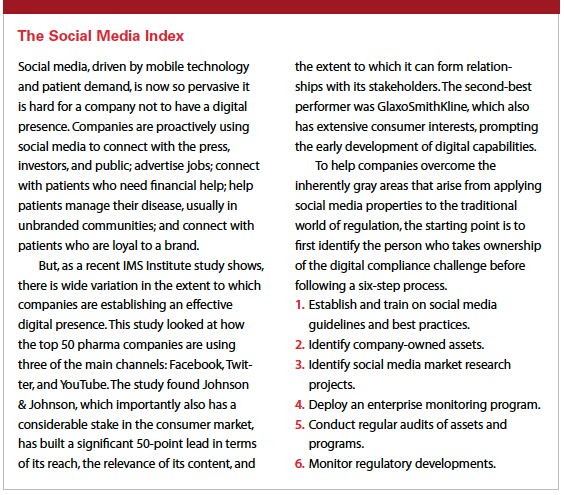 Engaging Patients Through Social Media
Engaging Patients Through Social Media
Siva Nadarajah, General Manager of Social Media, IMS Health, talks about how pharma companies can be successful in social media.
PV: Why is social media important for pharmaceutical companies?
Nadarajah: Social media can provide a great lens into sentiment, opportunities, and threats for a particular brand much earlier than traditional methodologies. Also, pharma companies have started to map the patient journey for disease states to better understand the unmet needs and emotions of patients.
Social media is a great data asset to map the patient journey without any biases of traditional survey-based approaches.
Lastly, social media can be used as a new bidirectional channel to communicate with patients to educate them about disease awareness and drug adherence.
PV: What are the pharmaceutical companies that scored highest on the IMS Health social media index doing right?
Nadarajah: They create niche communities that are very focused on a disease state at a regional or country level. They are able to engage with patients much better than others because of this focused approach.
Also these companies distribute relevant information to patients. If someone comments on your post, you have to get back to them immediately. If you don’t have real-time responses, people won’t engage with you.
These companies also handle compliance effectively. As a way for companies to be transparent, we provide our clients a solution called AETracker to manage social media risks. Early adopters have embraced the tool and have been sucessful. The consumer health companies, which have the same level of regulatory rigor, have successfully put these tools in place for many years now. It’s encouraging to see pharma finally embracing it.
PV: What steps should pharmaceutical companies take to have their social media efforts be successful?
Nadarajah: First, they need to develop an internal social media policy. And then they need to start by listening to social media channels. Once you have an understanding of what patients want, you can start engaging with them.
have an understanding of what patients want, you can start engaging with them.
Finally, you need to measure the success of your engagement. One way to measure the success is to view the organic impact of your effort on the Web. For example, let’s say you start a community to bring awareness to a disease state. You can measure if the search volume and Wikipedia visits for the disease are going up. It won’t happen overnight, but gradually you can see the impact.
Additionally, companies should not consider social media as a silo tactic. Social media has to be incorporated into the company’s end-to-end digital strategy. Social media insights can be used for designing a website to developing your mobile app to defining the next product messaging to physicians.
PV: How can pharmaceutical companies provide value to patients?
Nadarajah: Companies have to make content more relevant, focused, and educational. This provides value to the patient and helps companies earn patient trust. The moment a company becomes too commercial in social media, it loses the connection.
And that is why listening to social media is so important. By listening, companies can find out the things that patients want to talk about. Companies could find out, for example, that some patients are not happy with a particular support program. That could be a signal.
Then the company can formulate a good discussion thread around this topic in a company-sponsored community to get the exact details to fix the problem. (PV)
The Social Media Index
Social media, driven by mobile technology and patient demand, is now so pervasive it is hard for a company not to have a digital presence.
Companies are proactively using social media to connect with the press, investors, and public; advertise jobs; connect with patients who need financial help; help patients manage their disease, usually in unbranded communities; and connect with patients who are loyal to a brand.
But, as a recent IMS Institute study shows, there is wide variation in the extent to which companies are establishing an effective digital presence.
This study looked at how the top 50 pharma companies are using three of the main channels: Facebook, Twitter, and YouTube. The study found Johnson & Johnson, which importantly also has a considerable stake in the consumer market, has built a significant 50-point lead in terms of its reach, the relevance of its content, and the extent to which it can form relationships with its stakeholders. The second-best performer was GlaxoSmithKline, which also has extensive consumer interests, prompting the early development of digital capabilities.
To help companies overcome the inherently gray areas that arise from applying social media properties to the traditional world of regulation, the starting point is to first identify the person who takes ownership of the digital compliance challenge before following a six-step process.
1. Establish and train on social media guidelines and best practices.
2. Identify company-owned assets.
3. Identify social media market research projects.
4. Deploy an enterprise monitoring program.
5. Conduct regular audits of assets and programs.
6. Monitor regulatory developments.


















